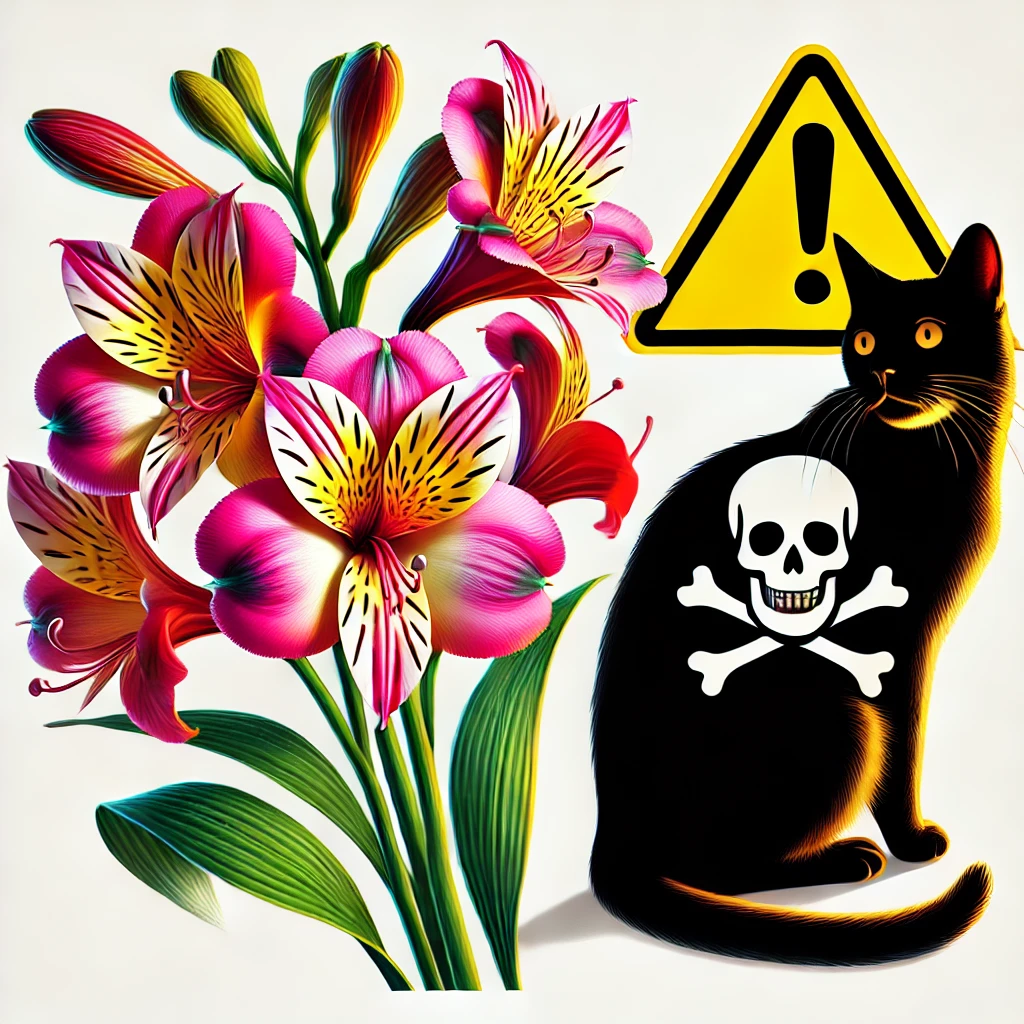Lily of the Incas, also known as Alstroemeria, are popular ornamental flowers prized for their vibrant colors and long-lasting blooms. As a cat owner, it’s crucial to understand the potential risks these plants may pose to your feline companion. This article explores the toxicity of Lily of the Incas to cats, discussing their chemical composition, possible symptoms of ingestion, and preventive measures to ensure your pet’s safety. We’ll also examine alternative pet-friendly plants and provide guidance on what to do if you suspect your cat has consumed any part of this plant. By the end of this post, you’ll have a comprehensive understanding of how to create a safe environment for your cat while still enjoying beautiful floral arrangements in your home.
Cats are known for their curious nature and tendency to explore their surroundings, often by nibbling on plants. While some houseplants are harmless, others can be toxic to our feline friends. Lily of the Incas, with its attractive appearance, may catch your cat’s attention. However, it’s essential to be aware of the potential risks associated with this plant. In this article, we’ll delve into the specifics of Lily of the Incas toxicity, helping you make informed decisions about which plants to keep in your home. We’ll also discuss the importance of recognizing symptoms of plant poisoning in cats and provide tips on creating a cat-friendly garden or indoor space. By understanding the relationship between cats and Lily of the Incas, you can ensure a safer environment for your beloved pet.
Understanding Lily of the Incas: An Overview
The Lily of the Incas, scientifically known as Alstroemeria, is a captivating genus of flowering plants that has garnered significant attention in the horticultural world. Native to South America, particularly regions once inhabited by the ancient Incas, these vibrant blooms have become increasingly popular in gardens and floral arrangements worldwide. With their striking colors and unique petal patterns, Alstroemeria flowers have earned a special place in the hearts of plant enthusiasts and florists alike.
Alstroemeria, commonly referred to as Peruvian Lily or Lily of the Incas, belongs to the family Alstroemeriaceae and encompasses approximately 50 species. These perennial plants are characterized by their long, sturdy stems adorned with lance-shaped leaves and topped with clusters of intricate, lily-like flowers. The blossoms of Alstroemeria typically feature six petals, often marked with streaks, spots, or brush strokes in contrasting colors, creating a mesmerizing visual display that can range from soft pastels to vivid, eye-catching hues.
The cultivation of Lily of the Incas has a rich history dating back centuries, with the Incas themselves recognizing the plant’s beauty and potential medicinal properties. In modern times, horticulturists have developed numerous hybrid varieties, expanding the color palette and improving the plant’s resilience. Here’s a brief overview of some popular Alstroemeria cultivars:
| Cultivar | Color | Characteristics |
|---|---|---|
| Alstroemeria ‘Inca Ice’ | White with pink flecks | Long-lasting blooms, ideal for cut flowers |
| Alstroemeria ‘Indian Summer’ | Orange with bronze highlights | Heat-tolerant, perfect for warmer climates |
| Alstroemeria ‘Princess Lily’ | Various pastel shades | Compact growth habit, suitable for containers |
While the Lily of the Incas is undoubtedly a beautiful addition to any garden or floral arrangement, it’s essential to consider its potential impact on pets, particularly cats. As responsible pet owners and plant enthusiasts, it’s crucial to be aware of the possible toxicity of certain plants to our feline companions. In the case of Alstroemeria, there are conflicting reports regarding its safety for cats, which underscores the importance of exercising caution and conducting thorough research before introducing these plants into a household with pets.
Potential Toxicity: Symptoms to Watch For in Cats
When it comes to the potential toxicity of Lily of the Incas to cats, pet owners must remain vigilant and informed about the possible symptoms that may arise if their feline companions come into contact with this plant. While the Incas were known for their advanced botanical knowledge, modern pet owners need to be aware of the risks associated with certain plants in their homes. It’s crucial to understand that the toxicity of Lily of the Incas can vary depending on the specific species and the amount ingested by the cat.
The symptoms of potential toxicity in cats exposed to Lily of the Incas can manifest in various ways, ranging from mild to severe. Some common signs to watch for include:
- Gastrointestinal distress (vomiting, diarrhea, and loss of appetite)
- Lethargy and weakness
- Excessive drooling or foaming at the mouth
- Difficulty breathing or rapid breathing
- Changes in heart rate or blood pressure
- Tremors or seizures in severe cases
It’s important to note that these symptoms may not appear immediately after ingestion and can develop over time, making it crucial for cat owners to monitor their pets closely if they suspect exposure to Lily of the Incas.
If you observe any of these symptoms in your cat and suspect they may have come into contact with Lily of the Incas or any other potentially toxic plant, it’s essential to seek immediate veterinary care. Quick action can make a significant difference in the outcome for your feline friend. As the saying goes:
Safe Alternatives: Cat-Friendly Plants for Your Home
While the Lily of the Incas may pose potential risks to our feline friends, there are numerous cat-friendly alternatives that can beautify your home without compromising your pet’s safety. These plants not only add a touch of nature to your living space but also provide a safe environment for your curious cats to explore. By choosing these alternatives, you can create a harmonious balance between your love for plants and the well-being of your feline companions.
Here’s a list of cat-safe plants that you can consider for your home:
- Spider Plant (Chlorophytum comosum): Known for its air-purifying qualities and easy maintenance.
- Boston Fern (Nephrolepis exaltata): A lush, green plant that thrives in humid environments.
- African Violet (Saintpaulia): Produces beautiful flowers and is compact, making it perfect for small spaces.
- Areca Palm (Dypsis lutescens): A tropical plant that adds a touch of elegance to any room.
- Polka Dot Plant (Hypoestes phyllostachya): Known for its colorful, spotted leaves that add a pop of color.
When selecting plants for your cat-friendly home, it’s essential to consider factors such as light requirements, watering needs, and overall care. For instance, the Spider Plant is incredibly versatile and can thrive in various light conditions, making it an excellent choice for both novice and experienced plant enthusiasts. On the other hand, the Boston Fern prefers higher humidity levels and indirect light, which may require a bit more attention to maintain its lush appearance.
| Plant Name | Light Requirements | Watering Frequency |
|---|---|---|
| Spider Plant | Indirect to bright light | Once a week |
| Boston Fern | Indirect light | Keep soil consistently moist |
| African Violet | Bright, indirect light | Water when soil is dry to touch |
It’s worth noting that while these plants are considered safe for cats, it’s always best to monitor your pet’s behavior around any new additions to your home. Some cats may still be tempted to nibble on leaves or dig in the soil, which can lead to minor digestive issues or messes. To minimize these risks, consider placing plants in areas that are less accessible to your cats or using deterrents such as citrus peels or commercial pet repellents around the base of the plants.
Frequently Asked Questions

Lily of the Incas, also known as Alstroemeria, are flowering plants popular in gardens and as cut flowers, known for their vibrant colors and long-lasting blooms.Yes, Lily of the Incas are considered toxic to cats. Ingesting parts of the plant can lead to gastrointestinal upset and other health issues.Symptoms of toxicity in cats may include vomiting, diarrhea, drooling, and lethargy. If your cat exhibits any of these signs after exposure, consult a veterinarian immediately.To keep your cat safe, avoid growing Lily of the Incas in your garden or keeping them in your home. Always check plant types before introducing new flora in your environment.Yes, many common plants are toxic to cats, including lilies, tulips, and certain types of ferns. It's advisable to research any new plants before bringing them home.If you suspect your cat has ingested any part of the Lily of the Incas, contact your veterinarian or an emergency animal poison control hotline immediately for guidance.While Lily of the Incas can be used in homes without pets, it's still wise to consider any visiting animals and potential toxicity. Always research before introducing new plants into your living space.


